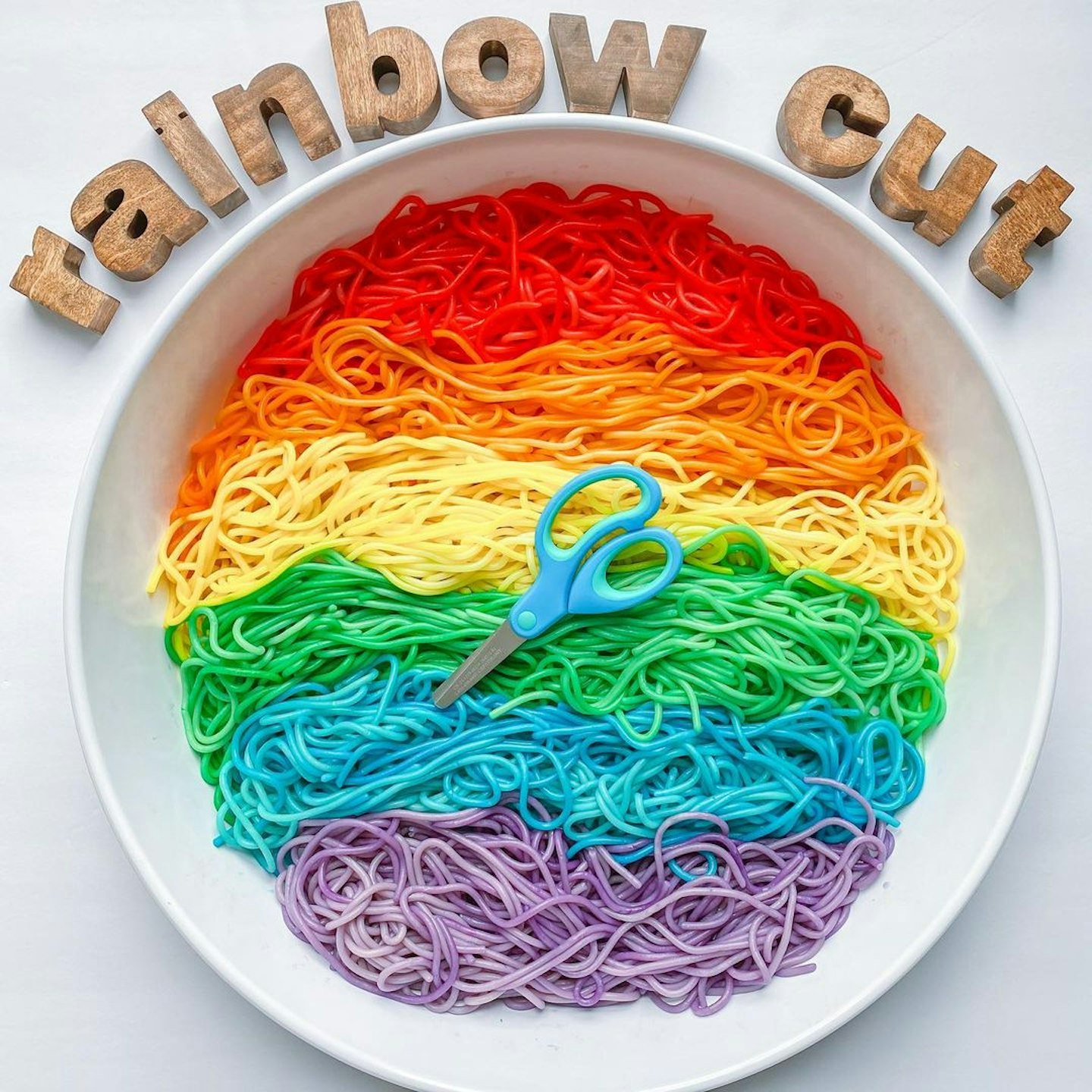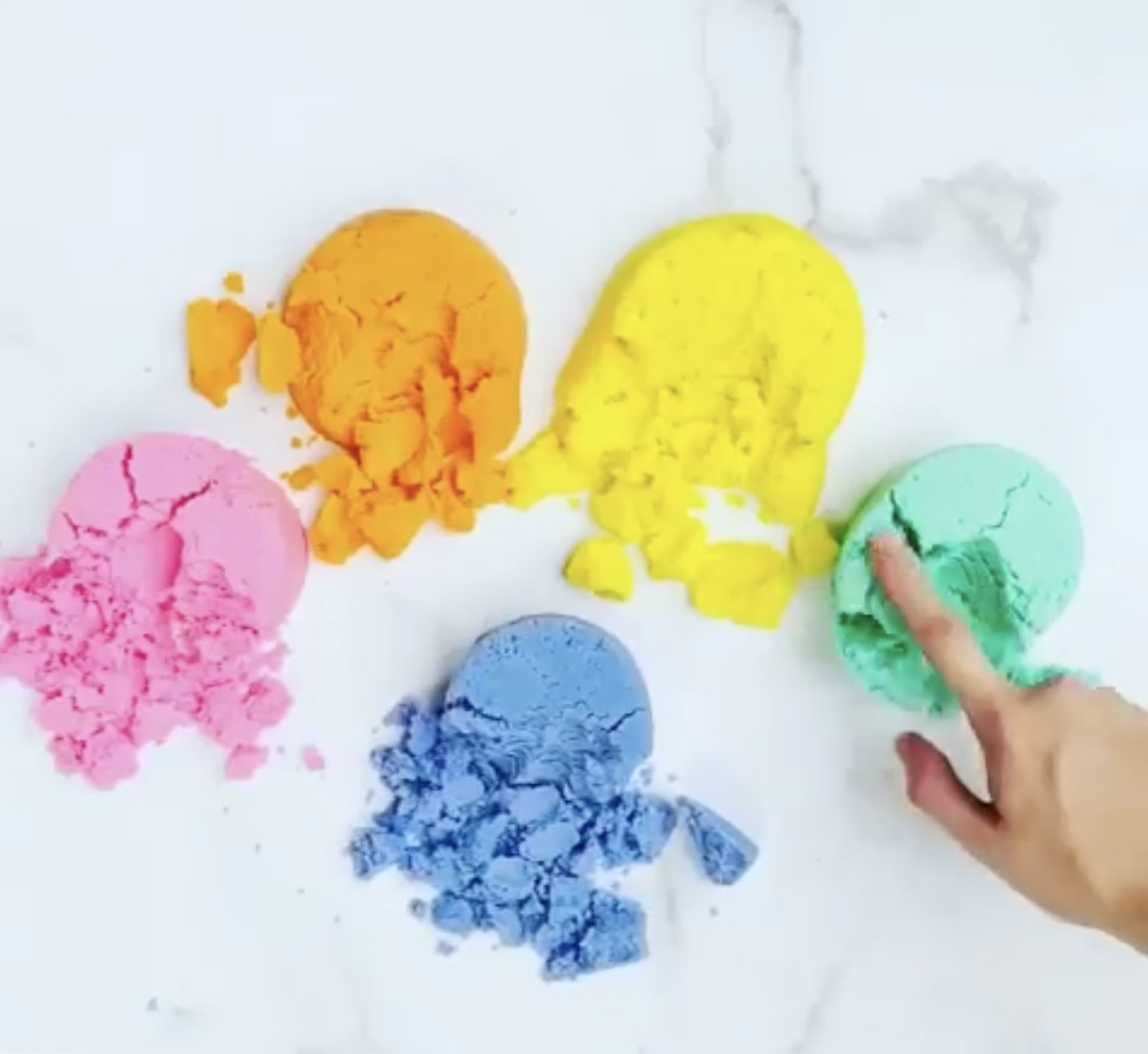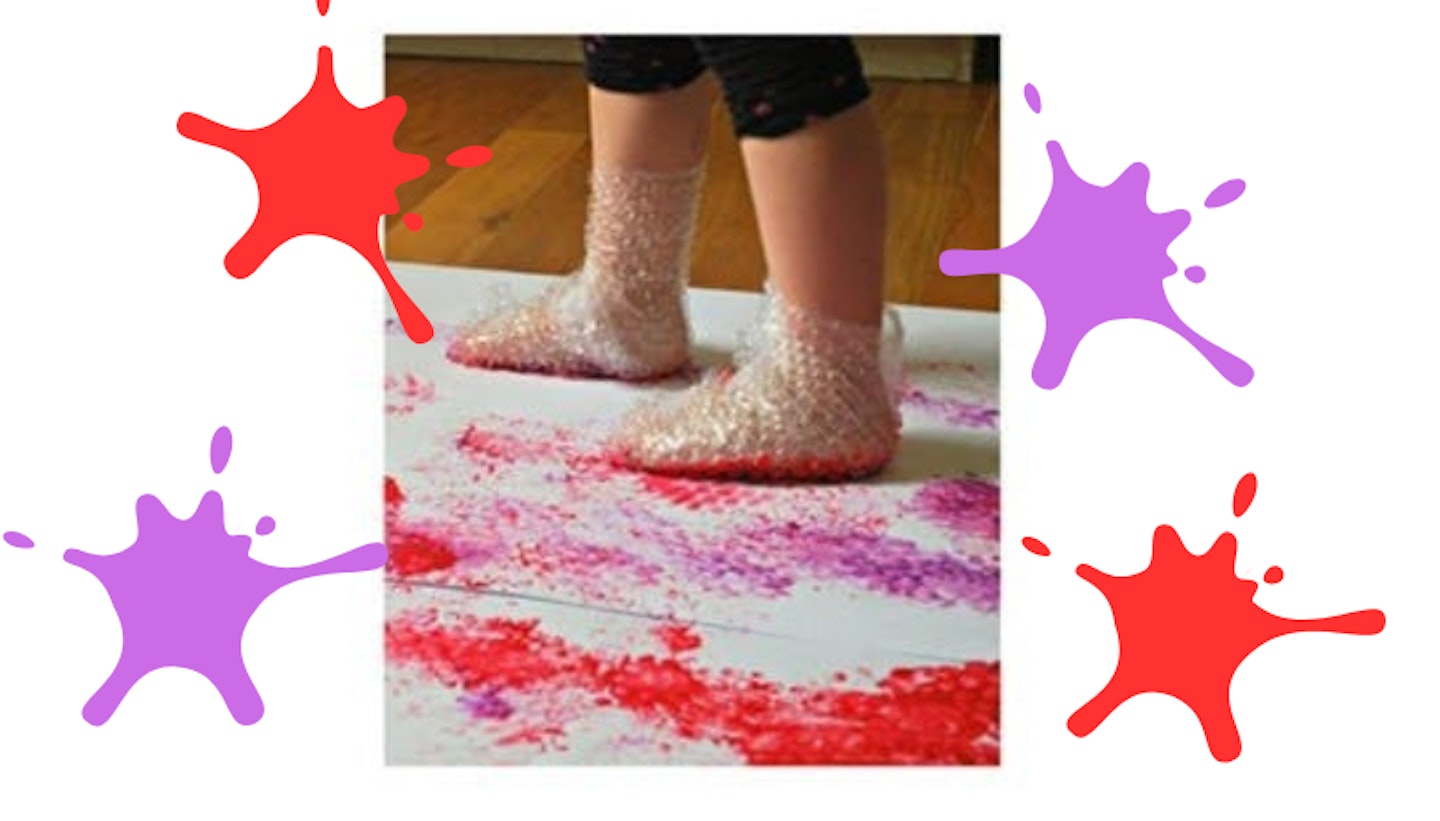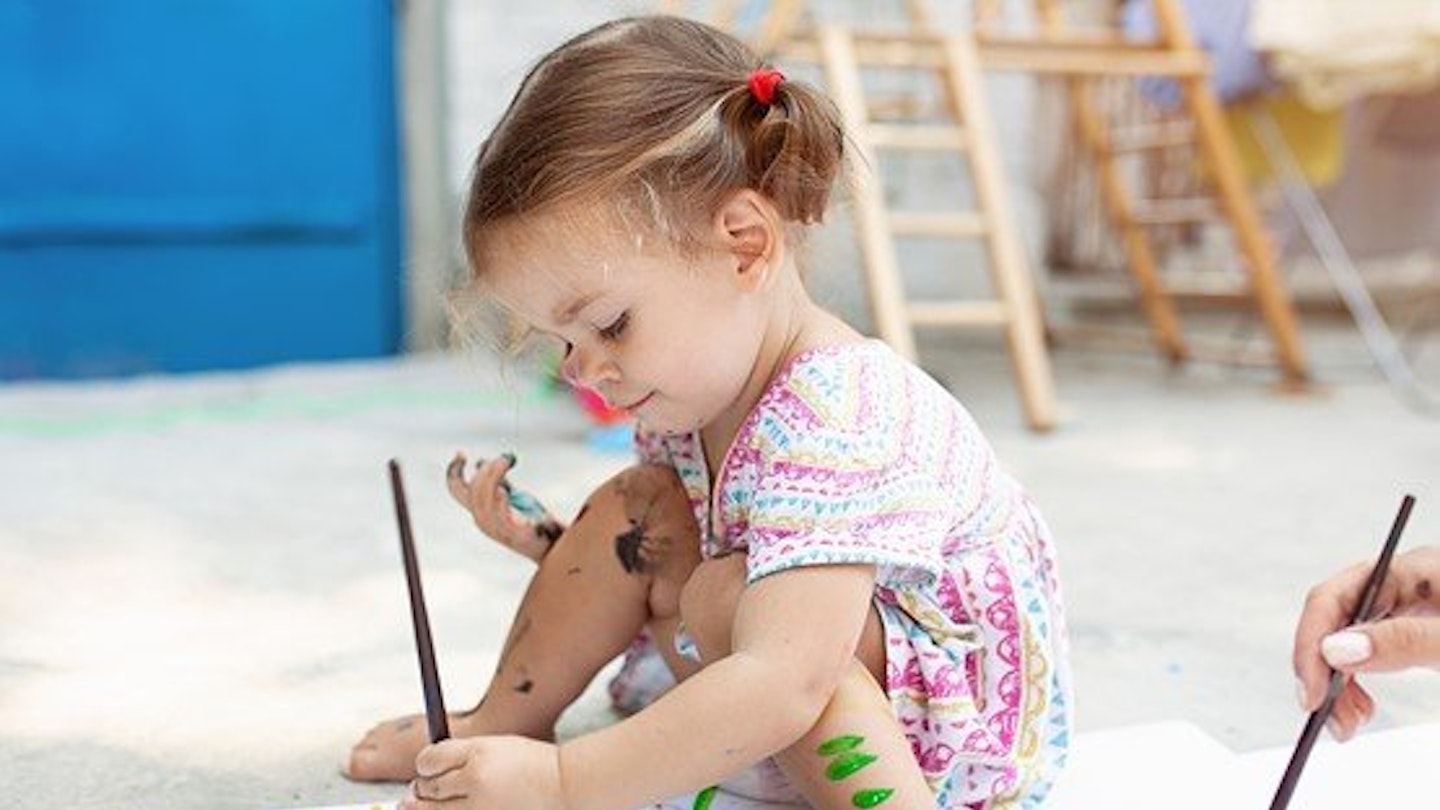Getting a little messy is something little ones love to do (and they're good at it), but sensory activities are also good for them! The NHS says that sensory play for toddlers is "a wonderful way to spend time with them and let them explore the world. It's all about stimulating their senses through touch, smell, taste, seeing and hearing."
Whether you're encouraging your tot to get elbow-deep in a sandpit or to crawl through a fabric-filled cardboard tunnel, there are loads of brilliant sensory play ideas for toddlers and ways you can stimulate your toddler’s senses at home. In doing so, you’ll help boost your little one’s learning, development and creativity while having lots of fun together.
"The playtime activities you do with your toddler are really important for their emotional and physical development", says the NHS, "They also help you to build a strong and connected relationship with them."
What is sensory play?
Children make sense of the world around them by interacting with it using all five of their senses. Sensory play taps into their natural curiosity by presenting them with a variety of fun objects and activities that enable them to practice using al of their senses, including touch, sight, hearing, smell and taste.
It can get a bit messy though, which is why play trays are often used to keep things together. The possibilities are endless when it comes to thinking up interesting play opportunities for toddlers, and as long as it's safe, they'll be very much entertained!
15 brilliant sensory play ideas for toddlers
Get the aprons at the ready, as things are bound to get mucky – but that's why toddler love messy sensory play...
1. Rainbow noodles

When it comes to toddler sensory play ideas, this one is a good one! Dye some noodles with different food colourings and put them all in a mixing bowl or on a tuff tray for your tot to play with. They'll adore the squidgy feeling and slippery texture of the noodles.Plus, the bright colours make them much more fun to look at!
Depending on how old your little one is, you could even add some child-friendly scissors and supervise them while they practice their cutting, as suggested by @growingupyang in their Instagram post.
Here are their instructions:
• Cook the pasta according to the package and drain
• Add equal parts to 6 different bags
• Add some food coloring and about a tablespoon of water to each bag
• Seal and mix the color in
• Drain each bag and do a quick rinse with water to get any extra dye off
• Some dye might rub off on hands, but it does dry after a bit!
They say, if you want to reuse, just place all of the pasta in a big bag and store in the fridge for up to a week.
2. Rainbow sludge

We think this sensory play idea looks like so much fun - we're sure you'll want to stick your fingers in just as much as they do!
All you need is:
• 1 cup baking soda
• 1/2 cup sugar
• 1/2 cup corn starch
• 1 tbsp cream of tartar
• Water
• Food colouring
And this is how you make it:
• Pour the baking soda, sugar, corn starch and cream of tartar into a bowl and mix
• Add a few drops of food colouring to 1/4 cup water
• Add 2 tbsp of water to the mixture and mix using a whisk until it's fluffy like snow
• Place in the refrigerator until cool
Store in a zip close bag or air tight container in the refrigerator.
3. Sponge fishing

Sponges and water are a great sensory play activity - in fact, any object plus water will provide hours of sensory fun for little ones. Add a fishing next though, and you can take it to the next level! We love how they've cut the sponges into the shape of fish here, and added rubber ducks for some variety of texture.
It's a good idea to set this up outside if the weather allows and you have a container that's big enough. Alternatively it can make a fun activite for supervised playtime in the bath.
4. Marshmallow making

Marshmallows have that unique bouncy texture that toddlers will find fun to squeeze. they smell really good and taste sweet though, so it's a good idea to save this sensory activity until they are a bit older, unless you're supervising very closely. The NHS says that marshmallows can pose a choking hazard for weaning babies and toddlers. Plus, they're jam-packed full of sugar, so they're not the healthiest snack either.
If your child is a bit older, you can make marshmallows into an even more fun and challenging sensory game by giving them blunt scewers or straws to make their own complex structures, like in the picture above!
5. Zip-lock bag mess-free painting

Sensory play is often associated with lots and lots of mess - but it doesn't have to be! This mess-free painting idea utilises a zip-lock bag to keep all the mess contained, and little ones can still enjoy moving the paint around using their hands to see the vibrant colours merge together. Trust us, they'll be mesmerised and love the feeling of the paint squidging underneath the plastic.
6 Fruit bowl

If you're looking for easy sensory play for toddlers - a simple fruit bowl provides plenty of opportunity for sensory play with exploration of textures, shapes, tastes and smells. You can fill a bowl of water with floating slices of lemons and give them a ladle, or just chop up different kinds of fruit and chuck them in a bowl for your toddler to investigate with their fingers.
They'll enjoy discovering the sour taste of lemons and the squidgy texture of bananas. Just be wary of adding things like grapes, which can be a choking hazard for weaning toddlers, and always supervise sensory play, especially when food is involved.
7. Cardboard tunnel

Cardboard boxes are often way more fun than the toys that came in them! Why not craft a cardboard tunnel big enough for your tot to crawl through? You can make it even more fun by attaching pieces of ribbon, pompoms and other hanging delights, as well as covering the floor with something interesting to crawl on like plastic wrap, taped down, of course! Make it even more magical with fairy lights, bells and a few soft toys along to find along the way.
8. Soapy sea foam

Soapy "sea foam" is really easy to make and kids will love playing in it with their sea creature toys. There are different ways to do this, from making a simple bubble bath to concocting your foam mixture using liquid soap, water, cornflour and a few squirts of liquid water colours in a bowl. We like the bathroom as a setting for this sosory play activity as the clean up is much easier!
9 Colander and straws

Little hands love to grab and pull things out - so sticking straws into a colander is a brilliant way to boost your tot's fine motor skills and hand-eye coordination. Fun sensory play activities for toddlers like this one are sure to keep them busy for a while. You'll have to supervise them closely though - you don't want them poking their eye out!
10 Herb scented play-doh

If you love taking your toddler out into the garden to play, don't let the weather put you off introducing plants to them during playtime. Herbs are great natural ingredients that are safe for your little one to play with, and you probably have some in your kitchen.
Stick a few different sprigs into a ball of play-doh and encourage your tot to explore the combination of the pliable play-doh texture with the interesting scents of the herbs.
11 Sand and sieves

You don't need a whole sand pit to provide sensory play for your toddler. A tuff tray or large plastic container will do, add a few solid items to "sieve" out of the sand (like numbered stones) and a plastic spade or kitchen spoon, and you have the recipe for a few hours of fun!
12 Bubblewrap stomping

Be warned: this activity is a messy one but it’s also so much fun. Wrap your toddler’s feet in bubble wrap and let them step in paint and stomp all over big sheets of paper. They can listen out for the popping sounds, watch the colourful paint patterns appear and feel the unusual soft texture on the soles of their feet.
13 DIY sensory bottles

DIY sensory bottles are supper easy to make and you can get really creative or keep it simple. Just fill plastic bottles with all sorts of things to activate your little one's senses - from pretty coloured water with glitter in it, to buttons and rice for lots of different sound makers.
14 Shredded paper sensory bin

Your toddler will have loads of fun hunting through shredded paper for their toys or other treasures you've hidden in there. Just fill the laundry basket or washing up bowl with lots of shredded paper for your tot to play with. They'll love the rustley noise it makes and the texture of the paper – it’s great for encouraging their sense of sound and touch. To avoid any paper cuts, we suggest opting for tissue paper.
Sensory Play FAQ
Sensory play is a hot topic because it's super trendy and super fun - so we know you'll have a few questions, and we've tried to answer some of them here...
Why is sensory play important?
Aside from being fun and keeping little ones busy and entertained, sensory play provides toddlers with learning opportunities that are essential for their healthy development. If you're wondering - how does sensory play help a child's development?Here are some of the benefits of sensory play according to Action For Children...
The benefits of sensory play:
• Demonstrates cause and effect - they'll learn how their own actions affect their environment and the things in it.
• Supports brain development - through problem solving and utilising memory and observation
• Helps develop fine motor skills - by allowing them to hold and direct objects
• Encourages creativity - they'll get to practice independent thinking while figuring out how things work, as well as make their own decisions as to how they want to play and explore
• Supports emotional regulation - Sensory play has a calming effect on children’s angry or anxious feelings as they get to focus on their physical senses instead
• Supports language development and social skill - interactive play encourages toddlers to communicate with parents and playmates.
When to start sensory play
You might be surprised to learn that babies are ready to start enjoying sensory play from birth! It's easy to stimulate their senses through everyday play and activities like talking and singing to them, providing toys that hang above their crib and move or make sounds, encouraging tummy time, and letting baby touch and hold things that are soft and safe - you don't want to end up with a screaming child who has just hit themselves with a wooden spoon, after all!
The type of sensory lay will depend on how old your little one is, as there are some sensory objects like water beads that are only suitable for older toddlers as they pose a choking hazard. Tuff trays are useful if your toddler hasn't learned to walk or crawl yet, as it'll help stop things from rolling out of reach.
How to do sensory play at home
The best way to do sensory play at home is to create areas that are easy to clean afterwards. This means using deep containers or large tuff trays to keep the mess in one place. Trays and containers also makes it easier for little one to reach everything as they'll contain things that might otherwise roll away.
Aside from sensory bins that will hold all sorts of objects and textured play things like sand and tissue paper, bowls of water are also handy for playing with things that float. Alternatively you can use a small paddling pool in the garden if the weather is right, or take playtime into the bath tub.
How to encourage sensory play
Some little ones can be a bit shy at first, and may need some encouragement when it comes to exploring the sensory play objects presented to them. You can simply demonstrate ways of interacting with the various things, and hand objects over to your toddler to experiment with.
You may need to guide them physically at first by taking hold of their hand to show them how to do things, but essentially sensory play is about independent exploration and communication, so talk and engage them with your voice too.
How to dye pasta for sensory play
Pasta is a popular item when it comes to sensory play because it's cheap to buy, can be used in so many different ways, and it doesn't go bad if you don't cook it, so you can reuse it another day.
You may want to dye the pasta so that it's rainbow-coloured and more child-friendly. Tou'll be pleased to know that you don't necessarily have to cook it in order to colour it.
How to dye dried pasta for sensory play:
• Measure about two cups of your dried pasta
• Add it to a resealable plastic bag
• Add 1/8 cup of white vinegar to a disposable cup
• Then add 20-30 drops of food coloring
• Stir it together and give it a test!
How to dye rice for sensory play
Dying rice for sensory play is a similar procedure to dying dried pasta.
To dye rice for sensory play, you can follow these steps:
• Add about 1 cup of rice to a resealable bag
• Mix a few drops of food coloring with 1/2 teaspoon of vinegar
• Add the mixture to the bag and shake until the rice is coated
• Repeat for each color of rice
• Spread the rice out in a thin layer on a baking tray lined with parchment or wax paper
• Let it dry for about 30 minutes to an hour
Extra tips for dying dried rice for sensory play:
• Add a few drops of essential oils for an olfactory experience
• The more food coloring you add, the deeper the color will be
• The vinegar smell is strong, so you can leave the rice outside to dry to help
Proud aunt to her teen niece, Zara Mohammed is a Digital Writer for Mother&Baby. She has 10 years freelance writing experience creating lifestyle content for various platforms, including pregnancy, women’s health, parenting, child development and child mental health, plus lots of fun seasonal family articles and celebrity news.
